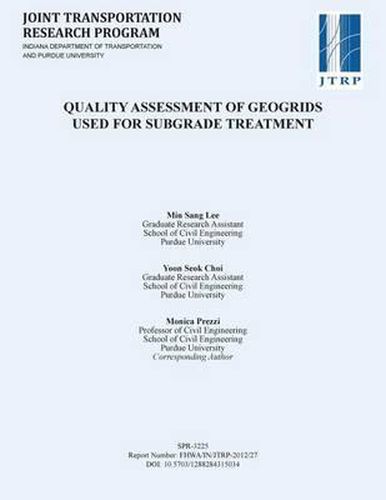Readings Newsletter
Become a Readings Member to make your shopping experience even easier.
Sign in or sign up for free!






Geogrid reinforcements have been used by the Indiana Department of Transportation (INDOT) to construct stable subgrade foundations and to provide a working platform for construction over weak and soft soils. Use of geogrid reinforcement in a pavement system ensures a long-lasting pavement structure by reducing excessive deformation and cracking. The main objectives of this research were to evaluate the mechanical interaction between a subgrade soil and an aggregate base layer with and without a geogrid in place at the interface. A series of large-scale direct shear tests were performed to investigate the effects of geogrid properties, such as geogrid aperture area, junction strength, and tensile strength, on the interface shear strength of soil-geogrid-aggregate systems. The test results showed that the aperture size and junction strength of the geogrids were relatively important factors affecting the overall interface shear strength the most. The average values for the peak interface shear strength coefficient for the three normal stresses (50 kPa, 100 kPa and 200 kPa) considered in this study ranged from 0.96 to 1.48. In addition, the test results showed that the average peak interface shear strength coefficient increases with increases in the junction strength of the geogrid. The optimum aperture area of the geogrid was found to be equal to 825 mm2 (1.4 in2) for the subgrade soil and aggregate considered in this study. There was no significant correlation between the geogrid tensile strength at 2% strain and the average peak interface shear strength coefficient. The effect of the moisture content of the subgrade soil on the peak interface shear strength coefficient was also investigated. The peak interface shear strength coefficient for the subgrade soil sample prepared at the optimum moisture content and compacted to relative compaction values of 94-96 % (Rsoil = 95-96% and Raggregate = 94-95%) and tested under a normal stress of 100 kPa was 20% less than that for the subgrade soil sample prepared at a moisture content 4% above the optimum moisture content. Based on the results of the tests performed in this study, an aperture area requirement of 825 mm2 (1.4 in2) and a junction strength requirement of 11.5 kN/m (788 lb/ft) were suggested as preliminary guidelines for subgrade reinforcement systems. These requirements are only limited to the use of Type IV geogrid (INDOT specification 207.04) for subgrade reinforcement with aggregate No. 53.
$9.00 standard shipping within Australia
FREE standard shipping within Australia for orders over $100.00
Express & International shipping calculated at checkout
Geogrid reinforcements have been used by the Indiana Department of Transportation (INDOT) to construct stable subgrade foundations and to provide a working platform for construction over weak and soft soils. Use of geogrid reinforcement in a pavement system ensures a long-lasting pavement structure by reducing excessive deformation and cracking. The main objectives of this research were to evaluate the mechanical interaction between a subgrade soil and an aggregate base layer with and without a geogrid in place at the interface. A series of large-scale direct shear tests were performed to investigate the effects of geogrid properties, such as geogrid aperture area, junction strength, and tensile strength, on the interface shear strength of soil-geogrid-aggregate systems. The test results showed that the aperture size and junction strength of the geogrids were relatively important factors affecting the overall interface shear strength the most. The average values for the peak interface shear strength coefficient for the three normal stresses (50 kPa, 100 kPa and 200 kPa) considered in this study ranged from 0.96 to 1.48. In addition, the test results showed that the average peak interface shear strength coefficient increases with increases in the junction strength of the geogrid. The optimum aperture area of the geogrid was found to be equal to 825 mm2 (1.4 in2) for the subgrade soil and aggregate considered in this study. There was no significant correlation between the geogrid tensile strength at 2% strain and the average peak interface shear strength coefficient. The effect of the moisture content of the subgrade soil on the peak interface shear strength coefficient was also investigated. The peak interface shear strength coefficient for the subgrade soil sample prepared at the optimum moisture content and compacted to relative compaction values of 94-96 % (Rsoil = 95-96% and Raggregate = 94-95%) and tested under a normal stress of 100 kPa was 20% less than that for the subgrade soil sample prepared at a moisture content 4% above the optimum moisture content. Based on the results of the tests performed in this study, an aperture area requirement of 825 mm2 (1.4 in2) and a junction strength requirement of 11.5 kN/m (788 lb/ft) were suggested as preliminary guidelines for subgrade reinforcement systems. These requirements are only limited to the use of Type IV geogrid (INDOT specification 207.04) for subgrade reinforcement with aggregate No. 53.